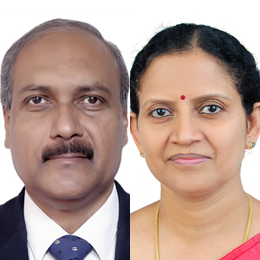
Data from a registry claimed to be the first prospective registry on mechanical thrombectomy for stroke in India have revealed a number of key insights on how this treatment is being implemented across the country. High revascularisation rates and good functional outcomes, as well as workflow metrics that are “comparable” with those seen in other geographies, are among researchers’ most notable findings.
Presenting these data from the Indian PRAAN registry at the 16th World Stroke Congress (WSC; 23–26 October, Abu Dhabi, United Arab Emirates), Jeyaraj Pandian (Christian Medical College and Hospital, Ludhiana, India)—who recently became the World Stroke Organization (WSO) president—and WSO board of directors member P N Sylaja (Sree Chitra Tirunal Institute for Medical Sciences and Technology, Trivandrum, India) initially highlighted the low overall utilisation of stroke thrombectomy in India. They cited high procedure costs, a lack of sufficient numbers of interventionists, and availability of only a few cath labs in the country, as the main drivers of this.
“With the current incidence of stroke [in India], we need to do more than 100,000 thrombectomies in a year—but we are doing fewer than 3,000–4,000,” Sylaja said, speaking to NeuroNews.
With this in mind, the prospective, multicentric, observational PRAAN registry was set up with the intention of studying patient characteristics, systems of care and functional outcomes associated with thrombectomy treatment in Indian patients with large vessel occlusion (LVO) acute ischaemic stroke.
More specifically, the registry includes stroke patients treated with the Solitaire X revascularisation device and/or the React catheter (both Medtronic) as the primary devices used. It has enrolled patients undergoing thrombectomy with stroke onset less than 24 hours from time last known well; Alberta stroke programme early computed tomography score (ASPECTS) >5; core infarct volume <70ml on non-contrast CT (NCCT) or diffusion-weighted magnetic resonance imaging (DW-MRI); and National Institutes of Health stroke scale (NIHSS) scores ≥6. An independent core lab and clinical events committee (CEC) assessed patient outcomes in the registry.
Pandian and Sylaja reported that, from August 2021 to October 2023, 200 patients were enrolled at 14 sites—of which 190 patients with an average age of just under 60 years met the eligibility criteria for PRAAN. The investigators relayed that, of these patients, 131 were treated using the Solitaire stent retriever, 19 were treated via aspiration thrombectomy using the React catheter, and 40 received a combined approach involving both Solitaire and aspiration. They also found that the majority of LVOs included in the study (55.3%) were M1 occlusions in the middle cerebral artery (MCA).
Pandian, Sylaja and colleagues ultimately found that these 190 patients experienced a median door-to-groin-puncture time of 99 minutes (range, 11–478), as well as a median groin-puncture-to-revascularisation time of 40 minutes (range, 10–170). In addition—and perhaps even more notably—the rate of successful revascularisation characterised by a modified thrombolysis in cerebral infarction (mTICI) grade ≥2b was 90.7% across a total of 184 patients, while functional independence defined as a 90-day modified Rankin scale (mRS) score of 0–2 was 65.8% based on a cohort of 187 patients.
Regarding more safety-centric outcome measures, the investigators observed a 2.1% rate of symptomatic intracranial haemorrhage (sICH) and a 6.3% rate of all-cause mortality across the full population of 190 patients.
Finally, Pandian and Sylaja reported that the majority of the 190 patients in the present registry (80%) were discharged home following their thrombectomy procedures and also relayed that—while the treatment is expensive—it was found to be cost effective overall.
“In spite of all the barriers to acute stroke treatment in India, this prospective registry was able to show that the performance metrics of [thrombectomy] and the functional outcomes at 90 days were similar to what has been reported globally,” Sylaja told NeuroNews. “Although this treatment is expensive, it is cost effective. This highlights the need of having more endovascular thrombectomy centres in India, and government reimbursement of this treatment, so that it will be available to all. Since LVO in acute ischaemic stroke leads to severe strokes, this life-saving treatment can reduce the burden of disability due to stroke.”
On a similar note, Pandian stated that, in his view, the main take-home message from this registry should be the positive patient outcome data, which are better than many previously reported figures.
New national standards
Also presenting at WSC 2024 was Kashipa Harit (Quality Council of India, Delhi, India), who cited data from a recent Global Burden of Diseases (GBD) study to emphasise the burden of stroke in India—including high rates of incidence (68.6%), deaths (70.9%) and disability-adjusted life years lost (77.7%).
Harit relayed that, back in November 2022, India’s National Accreditation Board of Hospitals and Healthcare Providers (NABH) signed a memorandum of understanding with the WSO to launch a national stroke centre certification programme, with the ultimate goal of helping to deliver consistent and effective treatments, improve patient outcomes, and reduce care variations.
A systematic questionnaire aligned with NABH and WSO standards has been used in an attempt to establish these national standards. According to Harit, it assesses five clinical and five non-clinical aspects of stroke care. These aspects include access; assessment and continuity of care; care of patients; management of medication; patient rights and education; infection control, patient safety and quality improvement; responsibilities of management; facility management and safety; human resource management; and information management systems.
Once established, the standards will be applied to stroke centres in order to investigate their effectiveness in greater detail. Harit reported that the standards seek to provide requirements that are “quantifiable, reasonable and feasible for centres” in optimising patient outcomes, minimising medical errors, and fostering a culture of continuous quality improvement. She also noted that the standards “hold promise for mitigating the burden of stroke in India” and improving the nation’s overall quality of healthcare delivery.










